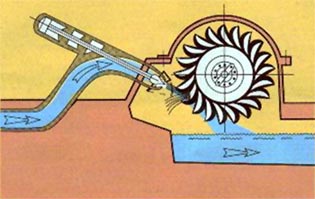HYDROELECTRIC ENERGY
Water was one of the first vector used for the production of energy. The kinetic energy the water produces as it flows down to the plain has been always exploited by man: the simple transport to the plain of logs cut on the mountains, the production of mechanical energy (mills) or electrical energy (hydroelectric turbines) ext.
Mills have been the only source of support and development of some areas otherwise depressed for centuries (mountain territories close to lakes and streams). Already in the 15th century mills were a meeting point of people carrying and trading in wheat, corn, oil ext.
Before the appearance of vapour in the 19th century, the paddle wheels were used to produce mechanical strength through the water of streams close to the human activity. The various mills used not only for grinding wheat but also to move hammers or saws are an example.
Hydroelectric Generators
The hydroelectric turbines are the most ancient turbine machines. They are the natural development of the least low and efficient watermills and they are now very widespread in Italy for the production of electrical energy (about 10% of the total energy produced in Italy).
The hydroelectric turbine is a rather simple machine, which has been widely studied recently. Indeed people know exactly all the problems related to its installation also in particular sites. The most important parts composing the hydroelectric turbine are the following ones:
| - |
The distributor, which manages the pressure and the form of the water jet on the mechanical runner, |
| - |
The mechanical runner,
which can have a different form and technology according to the type of plant, the head and the quantity of water, |
| - |
The electrical generator,
whose power and technical characteristics are proper to the type and size of runner and to the type of plant, |
| - |
The control system,
which can be mechanical and electric/electronic, which stabilizes the functioning of the system according to the correct values defined by the project.
|
|
 |
An HYDROELECTRIC plant is generally composed by:
| 1 |
a basin upstream with proper intake construction, which can be very small in case of a plant with flowing water or very big in case of a store plant (dams and artificial lakes), |
| 2 |
a penstock, |
| 3 |
the hydroelectric turbine |
| 4 |
the electrical generator, |
| 5 |
an on-off valve to switch off the machine in case of failure or maintenance periods, |
| 6 |
an output pipe, |
| 7 |
a possible basin downstream, |
| 8 |
the connection to the electrical grid with possible transformer for big distances. |
|
 |
|
|
